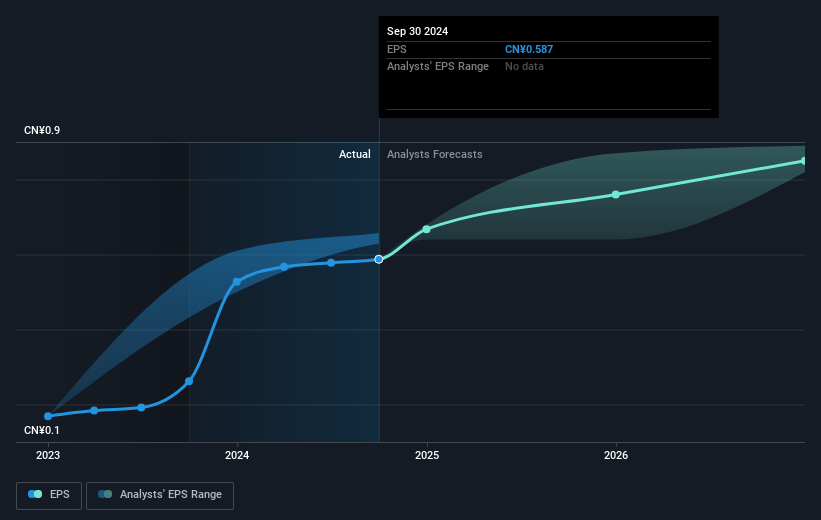Vatti (SZSE:002035) Sheds CN¥407m, Company Earnings and Investor Returns Have Been Trending Downwards for Past Five Years
Vatti (SZSE:002035) Sheds CN¥407m, Company Earnings and Investor Returns Have Been Trending Downwards for Past Five Years
Vatti Corporation Limited (SZSE:002035) shareholders should be happy to see the share price up 19% in the last quarter. But over the last half decade, the stock has not performed well. You would have done a lot better buying an index fund, since the stock has dropped 38% in that half decade.
華帝股份有限公司 (SZSE:002035) 的股東們應該對股價在上個季度上漲 19% 感到高興。 但在過去的五年中,這隻股票的表現不佳。 比起這隻股票下跌了 38%,買入一個指數基金的表現會好得多。
Since Vatti has shed CN¥407m from its value in the past 7 days, let's see if the longer term decline has been driven by the business' economics.
由於華帝在過去 7 天內市值蒸發了 40700萬人民幣,讓我們來看看長期的下滑是否是由業務的經濟因素驅動的。
While markets are a powerful pricing mechanism, share prices reflect investor sentiment, not just underlying business performance. One flawed but reasonable way to assess how sentiment around a company has changed is to compare the earnings per share (EPS) with the share price.
雖然市場是一個強大的定價機制,但股價反映的是投資者情緒,而不僅僅是基礎業務的表現。一種有缺陷但合理的評估公司情緒變化的方法是將每股收益(EPS)與股價進行比較。
Looking back five years, both Vatti's share price and EPS declined; the latter at a rate of 7.1% per year. This reduction in EPS is less than the 9% annual reduction in the share price. So it seems the market was too confident about the business, in the past.
回顧五年,華帝的股價和每股收益都出現了下降;後者的年降幅爲 7.1%。 每股收益的減少幅度低於股價每年 9% 的降幅。 所以看起來市場過去對業務的信心過於樂觀。
You can see how EPS has changed over time in the image below (click on the chart to see the exact values).
您可以在下面的圖像中查看每股收益隨時間的變化(單擊圖表查看確切值)。

We know that Vatti has improved its bottom line lately, but is it going to grow revenue? If you're interested, you could check this free report showing consensus revenue forecasts.
我們知道華帝最近提高了其底線,但它會增加營業收入嗎?如果你感興趣,可以查看這份免費的報告,顯示一致的營業收入預測。
What About Dividends?
關於分紅派息的問題
When looking at investment returns, it is important to consider the difference between total shareholder return (TSR) and share price return. Whereas the share price return only reflects the change in the share price, the TSR includes the value of dividends (assuming they were reinvested) and the benefit of any discounted capital raising or spin-off. It's fair to say that the TSR gives a more complete picture for stocks that pay a dividend. We note that for Vatti the TSR over the last 5 years was -30%, which is better than the share price return mentioned above. And there's no prize for guessing that the dividend payments largely explain the divergence!
在考慮投資回報時,重要的是要考慮總股東回報(TSR)和股價回報之間的差異。股價回報僅反映股價的變化,而TSR則包括分紅的價值(假設已再投資)以及任何折價融資或分拆的好處。可以公平地說,TSR爲支付分紅的股票提供了更完整的視角。我們注意到華帝過去五年的TSR爲-30%,這比上述的股價回報要好。毫無疑問,分紅支付在很大程度上解釋了這種差異!
A Different Perspective
不同的視角
It's nice to see that Vatti shareholders have received a total shareholder return of 32% over the last year. That's including the dividend. That certainly beats the loss of about 5% per year over the last half decade. The long term loss makes us cautious, but the short term TSR gain certainly hints at a brighter future. While it is well worth considering the different impacts that market conditions can have on the share price, there are other factors that are even more important. Consider risks, for instance. Every company has them, and we've spotted 1 warning sign for Vatti you should know about.
很高興看到華帝的股東在過去一年獲得了32%的總股東回報。這包括分紅。這肯定好於過去五年每年大約5%的損失。長期的損失讓我們感到謹慎,但短期的TSR增長無疑暗示了更光明的未來。雖然考慮市場條件可能對股價產生不同影響是非常重要的,但還有其他因素更爲重要。比如風險。每家公司都有風險,我們發現華帝有一個你應該知道的警示信號。
Of course, you might find a fantastic investment by looking elsewhere. So take a peek at this free list of companies we expect will grow earnings.
當然,你可能會通過其他地方尋找一個絕佳的投資機會。所以請查看這個我們預計將增長每股收益的公司免費列表。
Please note, the market returns quoted in this article reflect the market weighted average returns of stocks that currently trade on Chinese exchanges.
請注意,本文中引用的市場回報反映了目前在中國交易所交易的股票的市場加權平均回報。
Have feedback on this article? Concerned about the content? Get in touch with us directly. Alternatively, email editorial-team (at) simplywallst.com.
This article by Simply Wall St is general in nature. We provide commentary based on historical data and analyst forecasts only using an unbiased methodology and our articles are not intended to be financial advice. It does not constitute a recommendation to buy or sell any stock, and does not take account of your objectives, or your financial situation. We aim to bring you long-term focused analysis driven by fundamental data. Note that our analysis may not factor in the latest price-sensitive company announcements or qualitative material. Simply Wall St has no position in any stocks mentioned.
對本文有反饋?對內容有疑慮?請直接與我們聯繫。或者,發送電子郵件至 editorial-team (at) simplywallst.com。
這篇來自Simply Wall ST的文章是一般性的。我們根據歷史數據和分析師預測提供評論,採用無偏見的方法,我們的文章並不旨在提供財務建議。它不構成對任何股票的買入或賣出建議,也未考慮到您的目標或財務狀況。我們旨在爲您提供以基本數據驅動的長期分析。請注意,我們的分析可能未考慮最新的價格敏感公司公告或定性材料。Simply Wall ST在提到的任何股票中均沒有持倉。

 Looking back five years, both Vatti's share price and EPS declined; the latter at a rate of 7.1% per year. This reduction in EPS is less than the 9% annual reduction in the share price. So it seems the market was too confident about the business, in the past.
Looking back five years, both Vatti's share price and EPS declined; the latter at a rate of 7.1% per year. This reduction in EPS is less than the 9% annual reduction in the share price. So it seems the market was too confident about the business, in the past.